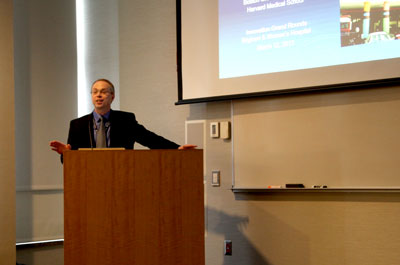The Clinician and the Engineer: How Partnerships Advance Medicine and Research

Pierre DuPont, PhD, of Boston Children’s Hospital, discusses the importance of collaboration among engineers and physicians at the Biomedical Research Institute’s Innovation Grand Rounds. |
During a two-part Innovation Grand Rounds held in March in the Shapiro Breakout Room, leading scientists presented on medical robotics research and applications.
The practicing innovation sessions, which are part of BWH's Office for Research Careers (ORC) and the Biomedical Research Institute's (BRI) Technology Innovation Program, are designed to be highly interactive. Directed by Frederick Schoen, MD, PhD, executive vice-chairman and chief of Cardiac Pathology, and organized and hosted by Kirby Vosburgh, PhD, associate director of BWH's Advanced Multimodality Image Guided Operating (AMIGO) suite, the sessions promote questions and dialogue about the practical nuts and bolts aspects of successful collaborations.
The first session featured presentations by Robert Howe, PhD, of Harvard's School of Engineering and Applied Sciences (SEAS), and Hiep Nguyen, MD, an associate professor of Surgery at Harvard Medical School and urologist at Boston Children's Hospital. Howe discussed the recent advances in cardiac ultrasound to guide interventions in the heart. Nguyen reviewed a broad range of robotics applications he has lead at Children's, ranging from the use of robots in fetal surgery to telepresence robots for making house calls.
During the second session, Pierre Dupont, PhD, a visiting professor of Surgery at Harvard Medical School and the Edward P. Marram Chair in Pediatric Cardiac Bioengineering at Children's Hospital, and Conor Walsh, PhD, a core faculty member at the Wyss Institute and assistant professor of Mechanical and Biomedical Engineering at Harvard's SEAS, focused on the importance of collaborations between clinicians and engineers in medical robotics research.
"The medical robotics research I do requires building collaborations with physicians and using surgical tools to address an unmet clinical need," said Dupont.
He guided attendees through a few examples of successful clinician-engineer partnerships he has led, including fetal cardiac interventions and intracardiac tissue approximation cases.
"A successful collaboration between engineers and clinicians requires that everyone involved is committed to the project, has complementary areas of expertise and can communicate well," he said. "Communication is especially important and involves problem-solving and having clear goals and expectations across the team."

Conor Walsh, PhD, of the Wyss Institute, gives a presentation about smart robotics tools at Innovation Grand Rounds. |
Walsh's presentation focused on surgical robotics tools, and he echoed DuPont's sentiments about the importance of partnerships throughout: "We are able to gain insight about the types of tools needed and evolve conceptual ideas to prototypes from our collaborations with physicians. The ultimate form and function of new tools comes from this physician-engineer collaboration."
One such partnership involved Walsh's invention of a robotic steerable needle to more accurately and precisely deliver thermal ablation to cancer patients. The robotic needle, which can lengthen, shorten, bend and curve, contains an electrode tip that burns multiple points in a tumor, sparing healthy surrounding tissue. Walsh heavily relied on physicians during the clinical testing of the device.
In addition to sharing medical innovations in practice, the Innovation Grand Rounds series seeks to build a community of clinicians and scientists interested in and driving translatable technologies and health care innovation. Presentations are held on the second Tuesday of the month, 4-6 p.m., in the Shapiro Breakout Room. To learn more, visit the Innovation Grand Rounds page.